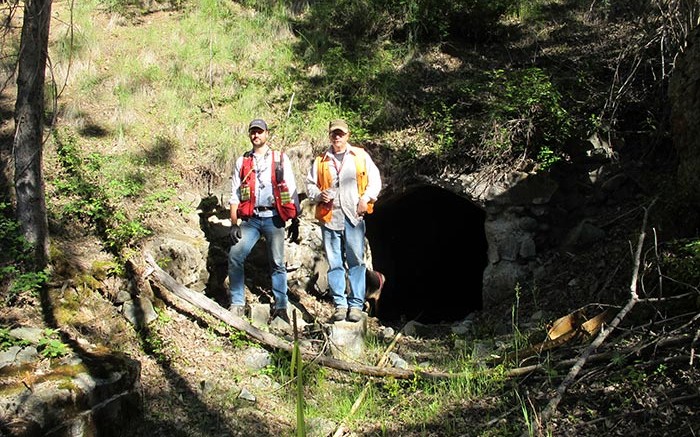VANCOUVER — Explorer Adamera Minerals (TSXV: ADZ; US-OTC: DDNFF) is hoping to contribute to a long history of gold mining in the prolific Cook Mountain district in northern Washington state. The region hosts Kinross Gold’s (TSX: K; NYSE: KGC) Kettle River mill, but with reserves dwindling at the producer’s low-cost Buckhorn gold deposit, it’s going to take some exploration ingenuity to keep operations running.
Enter Adamera, which has been sampling, mapping and drilling targets in the area over the past 18 months, and thinks Cook Mountain still has a lot of discovery upside. The region hasn’t been heavily explored since Echo Bay was operator before a merger with Kinross in the early 2000s.
“We’re focused on the area that has significant historic gold resources,” president and CEO Mark Kolebaba says during an interview. “It’s really been a ‘super mine.’ That’s not in terms of ounces necessarily, but in terms of really low operating costs and strong margins. Being in this area we view it as a brownfield opportunity, because we’re looking for ounces to feed an operating mill. Our big attraction is the power and road infrastructure, and the fact Kettle River is nearby and Buckhorn is scheduled to be out of ore by the end of the year.”
Adamera holds five properties in what’s been coined the “Republic district,” but its most promising targets are located on the Oversight and Flag Hill assets. The two property packages sit between the Torado and Republic grabens, which have constrained most major gold discoveries in the region.
In mid-January Adamera acquired data from nine historic holes drilled at Overlook that extend onto its Oversight property, with eight holes intersecting strong grades. Highlights from the data set include: 10.7 metres grading 11 grams gold from 174 metres deep in hole 1; 46 metres of 5.1 grams gold from 131 metres deep in hole 3; and 29 metres of 4.7 grams gold from 110 metres deep in hole 7.
Adamera identified a pair of gold-in-soil anomalies 700 metres south of the historic holes, including several areas with potential for economic mineralization based on anomalous gold and pathfinder element geochemistry. The company acquired claims north and northwest of Overlook that cover previously mined, high-graded portions of the deposit.
“When we drilled at Oversight we hit the carbonate, but we didn’t stop drilling. Typically anyone who had explored previously had stopped in the limestone because they were trying to extend Overlook,” Kolebaba explains. “Previous operators thought it was probably a fault that lifted it up, and when they didn’t hit mineralization they just stopped. We’re looking for an extension of Overlook under our property, and we’re also looking for a fold nose.
“Clearly we found a gold-bearing horizon that looks a lot like Overlook. We’ve outlined a beautiful soil anomaly with really nice gold, arsenic and copper values. It’s a target that’s never been tested. It’s looking now like the geophysics has been a bit of a red herring. I don’t think it is telling us that we have a magnetic body, but there’s actually an intrusive there,” he adds.
The company punched nine, shallow holes at Oversight last year, which returned elevated gold and copper-zinc values, with gold assays of up to 2.5 grams gold. Adamera says more drilling is needed to test for higher-grade zones at depth, and hopes to test its newly outlined geochemical anomalies.
The company is also chasing epithermal-vein mineralization at its Flag Hill prospect along the western edges of the Republic graben. In February Adamera announced it had identified two gold-bearing vein targets at the property parallel to the primary Flag Hill vein. A quartz boulder containing 4 grams gold was found along a 400-metre-long geochemical soil anomaly west of the Flag Hill vein. A similar, less extensive target was identified 200 metres east.
The geochemical anomalies are defined primarily by arsenic, a pathfinder element associated with gold mineralization on the property. The 400-metre-long linear arsenic anomaly coincides with a magnetic low and a linear topographic low, reflecting a structural control to the epithermal-vein system.
The company followed up in March when it reported a new target at Flag Hill after survey data delineated a sigmoidal-shaped (S-shaped), magnetic-low anomaly. The east–west trending anomaly is 225 metres long, and is bound to the east by a north–south trending fault and to the west by a newly identified north-south trending vein target. The anomaly also coincides with several rock samples bearing gold values ranging from 1 to 9.52 grams gold.
“We’ve really focused on geochemistry, and identified another major anomaly that hasn’t been drilled yet. We’re seeing consistently promising grades in samples. And then we look at the magnetics we find these beautiful S-shaped features common in many gold vein deposits,” Kolebaba says.
The company hopes it can put together a drill program at its new Oversight and Flag Hill targets in 2015, but financing remains a concern. In January Adamera announced a non-brokered private placement of 6 million units priced at 5¢ per unit for gross proceeds of $300,000. Each unit consists of a share and a 10¢ purchase warrant exercisable for two years. At press time, the financing remains open.
Adamera has traded within a 52-week range of 3¢ to 10¢, and closed at 3.5¢ per share. The company has 48 million shares outstanding for a $1.5-million market capitalization.
“An important feature of the new mining market is that there just isn’t big money around for exploration,” Kolebaba says. “You really need to limit risk and capital costs. We’re looking at a brownfield situation that could offer relatively short timelines from discovery. It’s a low-cost region and there’s potential for near-term production. There are also recoverable ounces in the ground at surrounding projects, and it’s definitely possible to build critical mass here.”


Be the first to comment on "Adamera envisions a golden future in Washington"